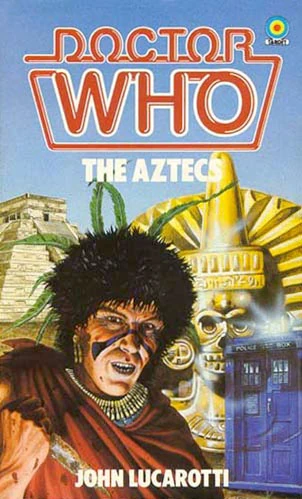The Aztecs
Doctor Who - The Aztecs

|
The Aztecs |
Target novelisation Doctor Who - The Aztecs |

|
| Author | John Lucarotti |  |
| Published | 1984 | |
| ISBN | 0 426 19588 4 | |
| First Edition Cover | Nick Spender |
| Back cover blurb: The TARDIS materialises in Mexico during the Aztec civilisation. The Doctor and his companions step outside to discover they are inside a tomb - the tomb, it turns out, of Yetaxa, once High Priest of the Aztecs. Barbara is hailed as Yetaxa's reincarnation by Autloc, High Priest of Knowledge, and Tlotoxl, High Priest of Sacrifice, when they find her in the precincts of the tomb wearing the bracelet of the deceased Priest, now revered as a god. And she takes advantage of her position of unaccustomed power to try and dissuade the Aztecs from practising human sacrifice... |
A Sacrificial Tome by Matthew Kresal 25/2/23
The Aztecs, being only the sixth ever broadcast Doctor Who TV story, has come to be regarded as something of a classic from the First Doctor era. Partly because it's a prime example of the "pure historicals" of that era but also because of how good it turned it to be as a production. So, one might be forgiven for thinking that its novelization, published twenty years later and written by the serial's original author, would make for a good read.
In reading this novelization in the opening days of 2023 (nearly forty years after its original publication), three things occurred to me. The first was that I had managed to read John Lucarotti's trio of Target books in reverse order over several years. The second was, having done that, I had never been impressed by his novelization of The Massacre (read in 2010) or Marco Polo (read in 2017). Third, and lastly, I was experiencing the book after having seen (and grown a fondness for) the original TV version, something that wouldn't have been unlikely when it was written and published.
With all that in mind, Doctor Who - The Aztecs was a mixed bag. Like his later two novelizations, Lucarotti found places to expand upon the original TV story two decades before. The Target version has an extra scene in the TARDIS before the TV serial's opening, leading into it. The sequence with Ian Chesterton making his way through a tunnel to get back into the tomb where the TARDIS landed, which becomes the basis for the part three cliffhanger on-screen, is also expanded upon here significantly. Freed from the confines of BBC TV Centre or what could be done quickly at Ealing on film, Lucarotti crafts a compelling version of the sequence as Ian struggles to crawl, swim and climb to reach his destination. It, like the grander sense of scale and peopling of the Aztec city, represents the novelization at its best.
Beyond that, the novelization suffers from many of the same issues that Lucarotti's later Target books would face. Namely, while Lucarotti could write solid dialogue, his descriptive details could border on the functional at best and paradoxically nondescript at worst. The bits of physical activity, the fight sequences between Ian and Ixta especially, are a prime example of that lack of detail. Indeed, the climactic confrontation isn't a fight but is reduced to an anti-climax. The expansions, as strong as the one with Ian in the pyramid tunnel, can be as troublesome as they are helpful. Take the one toward the end of chapter thirteen, which greatly expands on a scene from the TV serial's final episode with Barbara and Atloc, the High Priest of Knowledge. A scene that in prose features this bit from Atloc to Barbara:
"There is a legend I have heard, told to me by a wanderer from the desert, of another God far across the oceans, who spoke as you have spoken of gentleness and love, who was taken by those who opposed him and crucified as we crucify common thieves."Which has to be one of the oddest and most out of places pieces of prose I've come across in any work of literary Doctor Who to date.
The Aztecs then, on the page, isn't the gem its screen version was. While it has items of interest and expansions for fans of the serial, it reads oddly in places after nearly forty years. Then again, it's an artifact from another time and perhaps best read as such, even if it's a slight disappointment as a result.